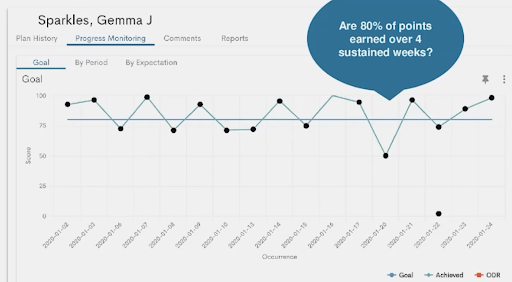How to Monitor Interventions Effectively and Ensure Intervention Fidelity
As educators, our goal is always to help our students succeed. For some students, an academic or behavioral intervention is necessary to help move their learning forward.
Monitoring student interventions and consistently collecting data about a student’s progress is a critical part of every intervention plan.
Understanding and interpreting the data collected can be a daunting process – but Illuminate Education is here to support you.
We’ll provide guidelines on what questions should be answered by collecting progress monitoring data and how intervention fidelity will lead to effective decision-making.
Table of Contents
- The Purpose of Intervention Monitoring for Students
- 4 Questions Intervention Data Should Be Answering
- How to Measure Intervention Effectiveness Using In the Student Plan Document
- Making a Decision on How to Move Forward Based on Intervention Monitoring Data
- How Illuminate Education Can Help You Effectively Monitor Interventions
The Purpose of Intervention Monitoring
Monitoring interventions is one component of progress monitoring. The information gained through the monitoring of interventions is used to make informed decisions about whether a student’s intervention(s) should …
- Continue as originally implemented
- Be modified; or
- Be intensified
… to ensure the intervention(s) match a student’s learning needs through the implemented changes/additions to their instruction and other educational supports.
Through intervention monitoring, a team can use the data gathered to determine if the intervention is truly working and whether or not to continue or exit the intervention placement.
If a student has overcome the challenge(s) that led to placing them into an intervention, they may successfully exit their placement.
On the other hand, the team may decide that a different approach needs to be implemented – including a possible referral to special education.
Illuminate Education’s progress monitoring tool helps educators successfully monitor both academic and behavior interventions to help close learning gaps sooner.

What Data Is Reviewed at the Intervention Meetings?
During an intervention meeting, an intervention Data Analysis Team (DAT) will meet to review a student’s progress monitoring reports and intervention data.
The goal of reviewing this data is to answer two main questions:
-
- Are we doing what we said we would do when this intervention was implemented?
- Are we doing it the way we intended?
The answers to these questions will be revealed through the student’s progress.
If the student has progressed exponentially, then the team can be assured they are doing what they said they’d do and the intervention is working as intended.
If the student has not improved, the DAT team needs to ask an additional question – has the student’s attendance been consistent, and have they been engaged in the process?
If so, the intervention likely needs to be altered. If not, it would be difficult to determine if the student truly isn’t making any progress or if the intervention needs to be altered.
The Intervention DAT will make decisions based on decision rules that were previously established, such as “cut-points” that have been put in place to assist with the decision-making process.
For example, a decision rule might be: to determine if an intervention needs to be altered, the data needs to show that a student is not meeting goals on at least three data points.
Ideally, with an organized process and a system that provides in-depth data, this process shouldn’t take more than three minutes per student.
Who Interprets the Intervention Data and How Often Do They Meet?
As mentioned above, intervention data is analyzed and interpreted by an Intervention Data Analysis Team (DAT).
This team typically consists of:
-
- A principal (or another administrative figure)
- An interventionist
- A data analyst (such as a school psychologist) – someone who can read progress monitoring data and understand what the data reveals
For academic interventions, the team typically meets every six weeks.
Behavior intervention meetings occur more often – about every three weeks. For these meetings, daily point sheets (like those used with Check-In/Check-Out) may be used to monitor progress and make decisions.
Four Questions Intervention Data Should Be Answering
1. Is There Enough Data to Make a Decision?
Decisions made using intervention monitoring data don’t always have to be “high-stakes decisions.” You simply want to be able to ensure that you are confident in the choices being made about the student.
To be confident about the decisions you make, you want to have at least six data points of measurement.
2. Is There a Lot of Variability in the Data?
Data variability refers to how spread out a set of data points are. With intervention monitoring, you don’t want to see a lot of variability in your data points.
When analyzing the data, look to see how often you are seeing very high and very low scores. Too much variability should lower your confidence in the reliability of the scores.
Variability could indicate that the student is distracted or that the measure is unreliable. So it’s important to look at the amount of bounce between data points.
The closer the points are, the more confident you can be that the trend line truly represents the skill being measured.
3. How Does the Student’s ROI Compare to the Goal?
A student’s rate of improvement (ROI) is determined by a Growth Report that determines the average growth between two scores (typically measured weekly).
It is important to compare a student’s current ROI to the goal that was set before the student was placed into an intervention.
Why?
A student can’t be successful if the goals set for them aren’t realistic. If a student’s ROI is consistently too low, their goals may need to be altered.
It’s important to remember that ROI can be difficult to interpret as a stand-alone factor. The growth report will also provide an ROI percentile rank which compares the student’s ROI to their peers.
4. What Is the Student’s Growth Percentile?
A student’s growth percentile (SGP) is:
“A score that indicates the growth or progress a student has made compared to their peer group on a given set of measures. For example, if a student has an SGP at the 75th percentile, this indicates that the performance of the student exceeded the growth or change of 74% of all students in the sample.”
If a student is only making average growth, it means they are likely going to stay at that level. When monitoring interventions, you want to see accelerated levels of growth – a higher growth percentile.
Is the Student Making “Catch-Up” Growth?
Catch-up growth refers to the improvements needed from students who start out significantly behind their peers.
This can be applied to both academic and social-emotional behavioral skills and essentially addresses the reality that those students who start out behind, will need to accelerate at a faster rate than their peers and classmates if they are going to “catch up.”
When monitoring interventions for catch-up growth, you’ll need to continually assess progress in relation to the goals set at the outset.
As an example, let’s take a look at a student’s social-emotional behavior intervention monitoring data. For this student to catch up, they have a goal of earning 80% of the points available to them through an intervention like Check-In/Check-Out.

How to Measure Intervention Effectiveness Using the Student Plan Document
The student plan document is part of the intervention monitoring process. This document may:
- Outline the implemented interventions
- Include student ROI and growth percentiles from past intervention meetings
- Track student attendance
- Document student participation and engagement
The student plan document allows you to determine if the intervention was implemented with fidelity.

Look for Intervention Fidelity
When an intervention is implemented as it was intended – meaning the implementation …
-
- Followed the original plan
- Was applied at the recommended frequency
- Continued for the recommended amount of time
- Measured benchmarks
- Was monitored correctly regularly
… You should be able to determine that the intervention was implemented with fidelity.
If, after reviewing the student plan document, you’re seeing that the intervention was not implemented with fidelity, you need to determine why.
Some common reasons for lack of intervention fidelity include:
-
- Instruction was not implemented accurately – not meeting the frequency or duration guidelines outlined in the implementation plan or not following guidelines for how instruction should be implemented.
- Frequent student absences – instruction can’t be implemented as it was intended if the student is rarely present.
- Lack of student engagement – instruction also can’t be implemented correctly if a student fails to engage with the activity.
- Incorrect progress assessment administration – sometimes the person conducting progress monitoring may not complete the progress with fidelity.
During intervention meetings, the team should review a student’s history to determine that intervention fidelity was upheld before making any decisions about how the student should move forward.
Making a Decision on How to Move Forward Based on Intervention Monitoring Data
After reviewing all available data, the Intervention DAT will decide how the student’s instruction and intervention(s) should move forward.
Outcomes of a team decision are typically one of the following:
- Continue the intervention – progress is evident, but the goal of the intervention has not been met. In this case, a new review date must be agreed upon.
- Change the intervention – the goal has not been met and progress isn’t evident. Another approach should be implemented.
- Fade the intervention – the goal has been met, but monthly monitoring will still occur to make sure progress continues.
- Exit the intervention – either the goal has been met (or the problem has been resolved), or the goal has not been met and the team believes progress is likely not possible.
Once a decision has been made, the team will need to explain their decision and document their rationale.

The Importance of Documenting Your Rationale
It is extremely important to document the rationale behind any decision made regarding a student intervention.
If the student’s records need to be reviewed at any point, detailed documentation will help you understand what was happening and why the team made the decision they did.
For example, if the team determines the student should exit his or her intervention, they should provide a data-centered reason why.
The team may recommend an exit from the intervention because:
-
- The intervention goal has been met
- The student may be better served through a 504 plan; or
- A referral to special education is needed
Whatever the reason, all rationale should be documented through a summarization of the supporting data in narrative form.
Recording the Decision and Following Up
Once a decision has been recorded, the Intervention DAT should always document any follow-up steps or activities and ensure they are completed.
Follow-up steps may include:
-
- Discussions with the student’s primary teacher
- Outreach to the student’s caregivers
- Scheduling the next intervention meeting (if applicable)
How Illuminate Education Can Help Effectively Monitor Interventions
At Illuminate Education, we understand the importance of monitoring interventions. But we also understand the enormous task that progress monitoring can be.
Our goal is to provide educators effective tools that can help with every step of the process so that interventionists can serve every child with the consistency needed to support progress – without sacrificing time or manpower.
Contact us today to learn more about our intervention monitoring tools such as FastBridge, eduClimber, and the Achievement Dashboard.
*****
Illuminate Education equips educators to take a data-driven approach to serving the whole child. By combining comprehensive assessment and MTSS management and collaboration tools, the Illuminate Solution enables educators to accurately assess learning, identify needs, align whole child supports, drive system-level improvements, and equitably accelerate growth for every learner.
Ready to discover your one-stop shop for your district’s educational needs? Let’s talk.


